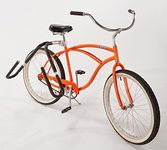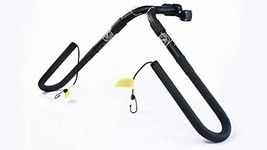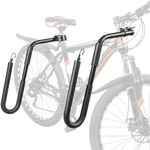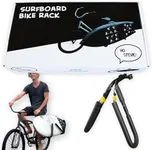Buying Guide for the Best Surfboard Bike Racks
Choosing the right surfboard bike rack can make your trips to the beach much more convenient and enjoyable. A good surfboard bike rack will securely hold your surfboard while you ride your bike, ensuring that both you and your board arrive safely. When selecting a surfboard bike rack, it's important to consider several key specifications to ensure you get the best fit for your needs. Here are the main specs to look at and how to navigate them.CompatibilityCompatibility refers to whether the surfboard bike rack can be attached to your specific bike model. This is important because not all racks fit all bikes. Some racks are designed for specific types of bikes, such as cruisers, mountain bikes, or road bikes. To pick the right one, check the manufacturer's specifications to ensure the rack is compatible with your bike. If you have a unique bike frame, look for adjustable or universal racks that can fit a variety of bike types.
CapacityCapacity indicates how many surfboards the rack can hold and the maximum size of the surfboards. This is crucial because you need a rack that can accommodate your board's dimensions. Racks typically range from holding one to two boards. If you usually surf alone, a single-board rack might suffice. However, if you often go with friends or have multiple boards, consider a rack with a higher capacity. Always check the maximum board size the rack can handle to ensure it fits your surfboard.
Mounting StyleMounting style refers to how the rack attaches to your bike. There are different styles, such as rear-mounted, side-mounted, or top-mounted racks. This is important because the mounting style affects the balance and handling of your bike. Rear-mounted racks are great for balance but can make it harder to mount and dismount your bike. Side-mounted racks are easier to access but can affect your bike's aerodynamics. Top-mounted racks keep the board out of the way but can make your bike top-heavy. Choose a mounting style that suits your riding habits and comfort.
Material and DurabilityThe material and durability of the rack determine how well it will hold up over time and under different weather conditions. Common materials include aluminum, steel, and high-strength plastics. This is important because a durable rack will provide better security for your surfboard and last longer. Aluminum racks are lightweight and resistant to rust, making them a good choice for coastal areas. Steel racks are very strong but can be heavier and prone to rust if not properly coated. High-strength plastics are lightweight and resistant to corrosion but may not be as strong as metal options. Consider the typical weather conditions you will be riding in and choose a material that offers the best balance of strength and durability for your needs.
Ease of InstallationEase of installation refers to how simple it is to attach and detach the rack from your bike. This is important because a rack that is difficult to install can be frustrating and time-consuming. Some racks come with quick-release mechanisms or tool-free installation, making them very user-friendly. Others may require tools and more time to set up. If you plan to frequently attach and remove the rack, look for one with an easy installation process. If you plan to leave the rack on your bike most of the time, installation ease might be less of a concern.
Security FeaturesSecurity features refer to the mechanisms in place to prevent theft of your surfboard or the rack itself. This is important because it ensures your surfboard remains safe while you are away from your bike. Some racks come with built-in locks or the ability to add a lock. Others may have secure mounting systems that make it difficult to remove the rack without tools. If you often leave your bike unattended, look for racks with robust security features to protect your investment.






















